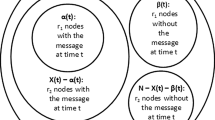Abstract
Reliable transmission in Intermittently Connected Mobile Networks (ICMNs) is a challenging work because the effective and reliable connection between the source and the destination can not be sustained. To reliably hand over data packets to the destination, many dissemination-based routing protocols are proposed. Dissemination-based routing protocols assure nodes including intermediate nodes and destinations have more chances to receive packets, which will increase the probability that the packets can be correctly received by the destination. However, the existing error recovery mechanisms in network layer use the simple CRC to check the data packets independently, and discard the error packets even if one correct packet can be obtained from more than one partly error packets. In this paper, first we propose a novel Network layer Error Recovery method (abbreviated as NER) based on Forward Error Correction (FEC). NER divides a data packet into Reed Solomon (RS) blocks and insert redundancy to each block. So the intermediate nodes and destinations can recover a correct data packet from multiple partially error copies of the same packet. Then we propose a novel routing protocol named NER-DRP based on the Epidemic routing and NER, which can improve the performance of ICMNs in terms of delivery ratio, end-to-end delay and count of hops.














Similar content being viewed by others
Reference
V. Cerf, S. Burleigh, and A. Hooke, “Delay-tolerant networking architecture,” IETF RFC4838, April, 2007.
K. Fall, “A delay-tolerant network architecture for challenged internet,” In Proceedings of SIGCOMM’03, Karlsruhe, Germany, Aug. 2003, pp. 27-34.
L. Pelusi, A. Passarella, and M. Conti, “Beyond MANETs: dissertation on opportunistic networking,” IIT-CNR. Tech. Rep., May 2006.
J. Sushant, K. Fall, and R. Patra, “Routing in a delay tolerant network,” Proceedings of SIGCOMM’04, Oregon, USA, August, 2004, pp. 145-158.
T. Hossmann, F. Legendre, and T. Spyropoulos, “From contacts to graphs: pitfalls in using complex network analysis for DTN routing,” Proceedings of INFOCOM Workshop on NetSciCom, Rio de Janeiro, Brazil, April 2009, pp. 1-6.
A. Vahdat and D. Becker, “Epidemic routing for partially connected ad hoc networks,” Tech. Rep. CS-2000-06, Department of Computer Science, Duke University, Durham, NC, 2000.
J. A. Davids, A. H. Fagg, and B. N. Levine, “Wearable computers as packet transport mechanisms in highly-partitioned ad-hoc networks,” Proceedings of ISWC’01, New York, USA, Oct. 2001, pp. 141-148.
B. Burns, O. Brock, and B. N. Levine, “MV Routing and capacity building in disruption tolerant networks,” Proceedings of IEEE INFOCOM, Miami, FL, USA, March 2005 pp. 398-408.
Balasubramanian A, Levine BN, Venkataramani A (2010) Replication routing in DTNs: a resource allocation approach. IEEE/ACM Trans on Networking 18(2):596–609
T. Spyropoulos, K. Psounis, and C. S. Raghavendra, “Spray and wait: an efficient routing scheme for intermittently connected mobile networks,” Proceedings of ACM SIGCOMM Workshop on Delay Tolerant Networks, Philadelphia, PA, USA, August 2005, pp. 252-259.
Y. Wang, S. Jain, M. Martonosi, and K. Fall, “Erasure coding based routing for opportunistic networks,” Proceedings of ACM SIGCOMM Workshop on Delay Tolerant Networks, Philadelphia, PA, USA, August 2005, pp. 229-236.
J. Widmer and J.Y. Le Boudec, “Network coding for efficient communication in extreme networks,” Proceedings of ACM SIGCOMM Workshop on Delay Tolerant Networks, Philadelphia, PA, USA, August 2005, pp. 284-291.
X. Chen and A. L. Murphy, “Enabling disconnected transitive communication in mobile ad hoc networks,” Proceedings of the Workshop on Principles of Mobile Computing (collocated with PODC’01), Newport, RI, USA, August 2001, pp. 21-27.
Lindgren A, Doria, Schelèn O (2003) Probabilistic routing in intermittently connected networks. Mobile Computing and Communications Review 7(3):19–20
M. Musolesi, S. Hailes, and C. Mascolo, “Adaptive routing for intermittently connected mobile ad hoc networks”, Proceedings of WoWMoM, Taormina-Giardini Naxos, Italy, June 2005, pp. 183 -189.
F. Tchakountio and R. Ramanathan, “Tracking highly mobile endpoints”, Proceedings of WoWMoM’, Rome, Italy, July 2001, pp. 83 - 94.
Guo H, Li J, Qian Y (2010) Hop-DTN: Modeling and Evaluation of Homing-Pigeon-Based Delay-Tolerant Networks. IEEE Transaction on vehicular technology 59(2):857–868
T. Hossmann, T. Spyropoulos, and F. Legendre, “Know thy neighbor: towards optimal mapping of contacts to social graphs for dtn routing,” Proceedings of IEEE INFOCOM, San Diego, CA, USA, March 2010, pp. 1-9.
Rizzo L (1997) Effective erasure codes for reliable computer communication protocols. Computer Communication Review 27(2):24–36
Jeng JH, Truong TK (1999) On decoding of both errors and erasures of a reed-solomon code using an inverse-free berlekamp-massey algorithm. IEEE Trans On Commun 47(10):1488–1494
J. G. Proakis, “Digital communication,” the fourth edition, McGraw-Hill Press, Oct. 2001.
Acknowledgment
The authors would like to thank the anonymous reviewers and editor for their valuable comments and suggestions. And thank the partly supporting by the National Science Foundation of China (61071118, 60702055), 973 program of Chian (2012CB316004), Natural Science Foundation Project of CQ CSTC.
Author information
Authors and Affiliations
Corresponding author
Rights and permissions
About this article
Cite this article
Li, Y., Wang, Z., You, X. et al. NER-DRP: Dissemination-based Routing Protocol with Network-layer Error Control for Intermittently Connected Mobile Networks. Mobile Netw Appl 17, 618–628 (2012). https://doi.org/10.1007/s11036-012-0354-6
Published:
Issue Date:
DOI: https://doi.org/10.1007/s11036-012-0354-6




